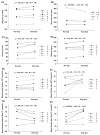Effects of 2-Week Exercise Training in Hypobaric Hypoxic Conditions on Exercise Performance and Immune Function in Korean National Cycling Athletes with Disabilities: A Case Report
- PMID: 32019079
- PMCID: PMC7037344
- DOI: 10.3390/ijerph17030861
Effects of 2-Week Exercise Training in Hypobaric Hypoxic Conditions on Exercise Performance and Immune Function in Korean National Cycling Athletes with Disabilities: A Case Report
Abstract
We aimed to evaluate the effects of a 2-week exercise training program in hypobaric hypoxic conditions on exercise performance and immune function in Korean national cycling athletes with disabilities. Six Korean national cycling athletes with disabilities participated in exercise training consisting of continuous aerobic exercise and anaerobic interval exercise in hypobaric hypoxic conditions. The exercise training frequency was 60 min (5 days per week for 2 weeks). Before and after the exercise training, exercise performance and immune function were measured in all athletes. Regarding the exercise performance parameters, the 3-km time trial significantly decreased and blood lactate levels after the 3-km time trial test significantly increased by exercise training in hypobaric hypoxic conditions. Regarding the oxygen-transporting capacity, significant differences were not observed. Regarding immune function, the number of leukocytes and natural killer cells significantly decreased and that of eosinophils, B cells, and T cells significantly increased. These results indicated that our 2-week hypoxic training showed the potential to improve exercise performance in Korean national disabled athletes. However, the effects of our hypoxic training method on immune function remained unclear.
Keywords: athletes with disability; exercise performance; hypobaric hypoxic training; immune function.
Conflict of interest statement
The authors declare no conflict of interest.
Figures



Similar articles
-
Effects of 2-week intermittent training in hypobaric hypoxia on the aerobic energy metabolism and performance of cycling athletes with disabilities.J Phys Ther Sci. 2017 Jun;29(6):1116-1120. doi: 10.1589/jpts.29.1116. Epub 2017 Jun 7. J Phys Ther Sci. 2017. PMID: 28626339 Free PMC article.
-
Interval Hypoxic Training Enhances Athletic Performance and Does Not Adversely Affect Immune Function in Middle- and Long-Distance Runners.Int J Environ Res Public Health. 2020 Mar 16;17(6):1934. doi: 10.3390/ijerph17061934. Int J Environ Res Public Health. 2020. PMID: 32188027 Free PMC article.
-
The Effect of Natural or Simulated Altitude Training on High-Intensity Intermittent Running Performance in Team-Sport Athletes: A Meta-Analysis.Sports Med. 2018 Feb;48(2):431-446. doi: 10.1007/s40279-017-0809-9. Sports Med. 2018. PMID: 29129021 Review.
-
Inspiratory Muscle Training: Improvement of Exercise Performance With Acute Hypoxic Exposure.Int J Sports Physiol Perform. 2019 Sep 1;14(8):1124-1131. doi: 10.1123/ijspp.2018-0483. Int J Sports Physiol Perform. 2019. PMID: 30702370 Clinical Trial.
-
Current trends in altitude training.Sports Med. 2001;31(4):249-65. doi: 10.2165/00007256-200131040-00002. Sports Med. 2001. PMID: 11310547 Review.
Cited by
-
Exercise intervention under hypoxic condition as a new therapeutic paradigm for type 2 diabetes mellitus: A narrative review.World J Diabetes. 2021 Apr 15;12(4):331-343. doi: 10.4239/wjd.v12.i4.331. World J Diabetes. 2021. PMID: 33889283 Free PMC article. Review.
-
Aerobic Continuous and Interval Training under Hypoxia Enhances Endurance Exercise Performance with Hemodynamic and Autonomic Nervous System Function in Amateur Male Swimmers.Int J Environ Res Public Health. 2021 Apr 9;18(8):3944. doi: 10.3390/ijerph18083944. Int J Environ Res Public Health. 2021. PMID: 33918616 Free PMC article.
-
Effects of Interval Training Under Hypoxia on Hematological Parameters, Hemodynamic Function, and Endurance Exercise Performance in Amateur Female Runners in Korea.Front Physiol. 2022 May 18;13:919008. doi: 10.3389/fphys.2022.919008. eCollection 2022. Front Physiol. 2022. PMID: 35665230 Free PMC article.
-
Hypoxic Pilates Intervention for Obesity: A Randomized Controlled Trial.Int J Environ Res Public Health. 2020 Sep 30;17(19):7186. doi: 10.3390/ijerph17197186. Int J Environ Res Public Health. 2020. PMID: 33008106 Free PMC article. Clinical Trial.
-
Effect of 4 Weeks of High-Intensity Interval Training (HIIT) on VO2max, Anaerobic Power, and Specific Performance in Cyclists with Cerebral Palsy.J Funct Morphol Kinesiol. 2025 Mar 24;10(2):102. doi: 10.3390/jfmk10020102. J Funct Morphol Kinesiol. 2025. PMID: 40566399 Free PMC article.
References
-
- Girard O., Amann M., Aughey R., Billaut F., Bishop D.J., Bourdon P., Buchheit M., Chapman R., D’Hooghe M., Garvican-Lewis L.A., et al. Position statement—Altitude training for improving team-sport players’ performance: Current knowledge and unresolved issues. Br. J. Sports Med. 2013;47(Suppl. 1):i8–i16. doi: 10.1136/bjsports-2013-093109. - DOI - PMC - PubMed
Publication types
MeSH terms
LinkOut - more resources
Full Text Sources
Medical

